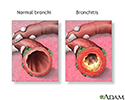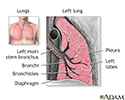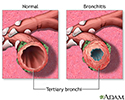Industrial bronchitis
Occupational bronchitis
Industrial bronchitis is swelling (inflammation) of the large airways of the lungs that occurs in some people who work around certain dusts, fumes, smoke, or other substances.
Bronchitis
Acute bronchitis is swelling and inflamed tissue in the main passages that carry air to the lungs. This swelling narrows the airways, which makes it...

Causes
Exposure to dusts, fumes, strong acids, and other chemicals in the air causes this type of bronchitis. Smoking may also contribute.
You may be at risk if you are exposed to dusts that contain:
- Asbestos
- Coal
- Cotton
- Flax
- Latex
- Metals
- Silica
- Talc
- Toluene diisocyanate
- Western red cedar
Symptoms
Symptoms may include any of the following:
-
Cough
that brings up mucus (sputum)
Cough
Coughing is an important way to keep your throat and airways clear. But too much coughing may mean you have a disease or disorder. Some coughs are d...
 ImageRead Article Now Book Mark Article
ImageRead Article Now Book Mark Article -
Shortness of breath
Shortness of breath
Breathing difficulty may involve:Difficult breathingUncomfortable breathingFeeling like you are not getting enough air
 ImageRead Article Now Book Mark Article
ImageRead Article Now Book Mark Article -
Wheezing
Wheezing
Wheezing is a high-pitched whistling sound during breathing. It occurs when air moves through narrowed breathing tubes in the lungs.
 ImageRead Article Now Book Mark Article
ImageRead Article Now Book Mark Article
Exams and Tests
The health care provider will listen to your lungs using a stethoscope. Wheezing sounds or crackles may be heard.
Tests that may be ordered include:
-
Chest CT scan
Chest CT scan
A chest CT (computed tomography) scan is an imaging method that uses x-rays to create cross-sectional pictures of the chest and upper abdomen....
 ImageRead Article Now Book Mark Article
ImageRead Article Now Book Mark Article -
Chest x-ray
Chest x-ray
A chest x-ray is an x-ray of the chest, lungs, heart, large arteries, ribs, and diaphragm.
 ImageRead Article Now Book Mark Article
ImageRead Article Now Book Mark Article -
Pulmonary function tests
(to measure breathing and how well the lungs are functioning)
Pulmonary function tests
Pulmonary function tests are a group of tests that measure breathing and how well the lungs are functioning.
 ImageRead Article Now Book Mark Article
ImageRead Article Now Book Mark Article
Treatment
The goal of treatment is to reduce the irritation.
Getting more air into the workplace or wearing masks to filter out the offending dust particles may help. Some people may need to be taken out of the workplace.
Some cases of industrial bronchitis go away without treatment. Other times, a person may need inhaled anti-inflammatory medicines. If you are at risk or have experienced this problem and you smoke, stop smoking.
Helpful measures include:
- Breathing humidified air
- Increasing fluid intake
- Resting
Outlook (Prognosis)
The outcome may be good as long as you can stop being exposed to the irritant. Chronic disability from industrial bronchitis is rare.
Chronic
Chronic refers to something that continues over an extended period of time. A chronic condition is usually long-lasting and does not easily or quick...

Possible Complications
Continued exposure to irritating gases, fumes, or other substances can lead to permanent lung damage.
When to Contact a Medical Professional
Call your provider if you are regularly exposed to dusts, fumes, strong acids, or other chemicals that can affect the lungs and you develop symptoms of bronchitis.
Prevention
Control dust in industrial settings by wearing face masks and protective clothing, and by treating textiles. Stop smoking if you are at risk.
Get early screening by a doctor if you are exposed to chemicals that can cause this condition.
If you think a chemical you work with is affecting your breathing, ask your employer for a copy of the Material Safety Data Sheet. Bring it with you to your provider.
References
Lemière C, Vandenplas O. Asthma in the workplace. In: Broaddus VC, Mason RJ, Ernst JD, et al, eds. Murray and Nadel's Textbook of Respiratory Medicine . 6th ed. Philadelphia, PA: Elsevier Saunders; 2016:chap 72.
Tarlo SM. Occupational lung disease. In: Goldman L, Schafer AI, eds. Goldman-Cecil Medicine . 25th ed. Philadelphia, PA: Elsevier Saunders; 2016:chap 93.
-
Bronchitis - illustration
Bronchitis is the inflammation of the bronchi, the main air passages to the lungs. It generally follows a viral respiratory infection. Symptoms include coughing, shortness of breath, wheezing and fatigue.
Bronchitis
illustration
-
Lung anatomy - illustration
When air is inhaled through the nose or mouth, it travels down the trachea to the bronchus, where it first enters the lung. From the bronchus, air goes through the bronchi, into the even smaller bronchioles and lastly into the alveoli.
Lung anatomy
illustration
-
Bronchitis and Normal Condition in Tertiary Bronchus - illustration
Bronchitis is an inflammation of the air passages in the lungs. The condition occurs over a long period and recurs over several years. Symptoms include excessive bronchial mucus with a cough producing sputum. Cigarette smoking (active and passive exposure) is the chief cause of this disease, with air pollution, infection, familial factors, and allergies as exacerbating factors.
Bronchitis and Normal Condition in Tertiary Bronchus
illustration
-
Respiratory system - illustration
Air is breathed in through the nasal passageways, travels through the trachea and bronchi to the lungs.
Respiratory system
illustration
-
Bronchitis - illustration
Bronchitis is the inflammation of the bronchi, the main air passages to the lungs. It generally follows a viral respiratory infection. Symptoms include coughing, shortness of breath, wheezing and fatigue.
Bronchitis
illustration
-
Lung anatomy - illustration
When air is inhaled through the nose or mouth, it travels down the trachea to the bronchus, where it first enters the lung. From the bronchus, air goes through the bronchi, into the even smaller bronchioles and lastly into the alveoli.
Lung anatomy
illustration
-
Bronchitis and Normal Condition in Tertiary Bronchus - illustration
Bronchitis is an inflammation of the air passages in the lungs. The condition occurs over a long period and recurs over several years. Symptoms include excessive bronchial mucus with a cough producing sputum. Cigarette smoking (active and passive exposure) is the chief cause of this disease, with air pollution, infection, familial factors, and allergies as exacerbating factors.
Bronchitis and Normal Condition in Tertiary Bronchus
illustration
-
Respiratory system - illustration
Air is breathed in through the nasal passageways, travels through the trachea and bronchi to the lungs.
Respiratory system
illustration
Review Date: 11/14/2016
Reviewed By: Denis Hadjiliadis, MD, MHS, Paul F. Harron Jr. Associate Professor of Medicine, Pulmonary, Allergy, and Critical Care, Perelman School of Medicine, University of Pennsylvania, Philadelphia, PA. Also reviewed by David Zieve, MD, MHA, Medical Director, Brenda Conaway, Editorial Director, and the A.D.A.M. Editorial team.




